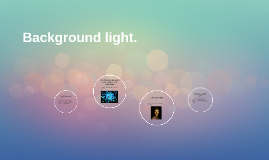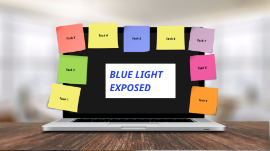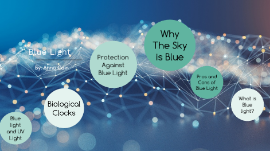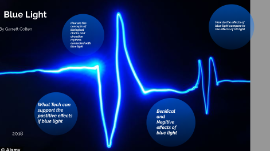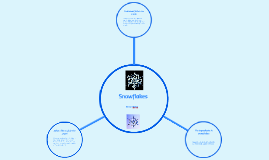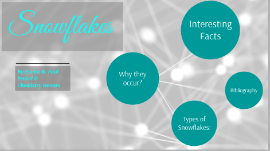Blue light
Transcript: By: Anna Cain Blue Light The light that comes from the sun appears white, but it is actually made of every color of the rainbow. As light passes through a prism, the light is separated into all of its colors. The prism is a specifically shaped crystal. Light energy travels in waves. Some light travels in short waves, and others in long waves. Blue light waves are shorter than red light waves. Sunlight reaches earth's atmosphere and is scattered in all directions by the particles and gasses in the air. The blue light is scattered more because it travels in shorter, smaller waves. This is the reason the sky is blue majority of the time. Why the Sky is Blue Why The Sky is Blue Blue light, or high energy visible (HEU) light, is a type of light with short wavelengths emitting a higher energy. It has one of the shortest, high energy wavelengths on the spectrum. In natural sunlight, blue light is always visible, but blue light is not only in sunlight. TV's, computers and phones use blue light for their screens. What is Blue Light? What is Blue light? Pros and Cons of Blue Light Pros: Blue light can help boost alertness Boost memory and cognitive function May even elevate your mood Cons: Can lead to eye strain Could lead to damage in retina cells (Cells found in the eye Potential molecular degeneration - Blurred or loss of vision Leads to sleeping issues, restlessness Blue light can disrupt your biological clock To an extent, blue light can lead to cancer Pros and Cons of Blue Light Blue light is both good and bad, and the difference is balance. If you only expose yourself to a limited amount of it, there will be positive effects, such as mood elevation. But, if you expose yourself to too much, all of the negative impacts will take effect on you, such as eye strain, molecular degeneration, and others. If you find the right balance, blue light will be safe to use. The Difference The Difference Protection Against Blue Light Protection Against Blue Light One technology used to prevent blue light reaching your eyes is a type of screen protector. This thin, clear screen protector has a blue light filter on it. Therefore, the blue light does not go through the screen and to your eyes. Another technology used today is blue light glasses. These glasses have a blue light filter in the lens. When you wear these blue light glasses, the negative effects and rays will not reach your eyes. Biological Clocks Biological Clocks Biological clocks and circadian rhythms are connected to blue light. Biological clocks and circadian rhythms is an internal mechanism that controls the psychological activities of yourself. It can change daily, weekly and yearly. They are connected to blue light because when you are exposed to blue light, it alters our biological clock, which is the reason that when you are exposed to it, you have troubles sleeping, and your internal schedule is altered. Sunlight contains both ultraviolet (UV) light and blue light. UV light is part of the non-visible light spectrum. Everyday, when we are out in the sun, we are exposed to UV light. It can cause damage to our eyes, specifically the lens and cornea. UV light can cause sunburn and destruction of vitamin A. It can lead to skin thickening, wrinkling and possible damage to DNA. Blue light, which is part of the visible light spectrum, goes deeper into the eye, and can cause permanent damage to the retina, which leads to problems such as molecular degeneration. In conclusion, UV light is more negatively damaging to the whole body, and blue light only takes effect on the eyes. Blue Light and UV Light Blue light and UV Light






